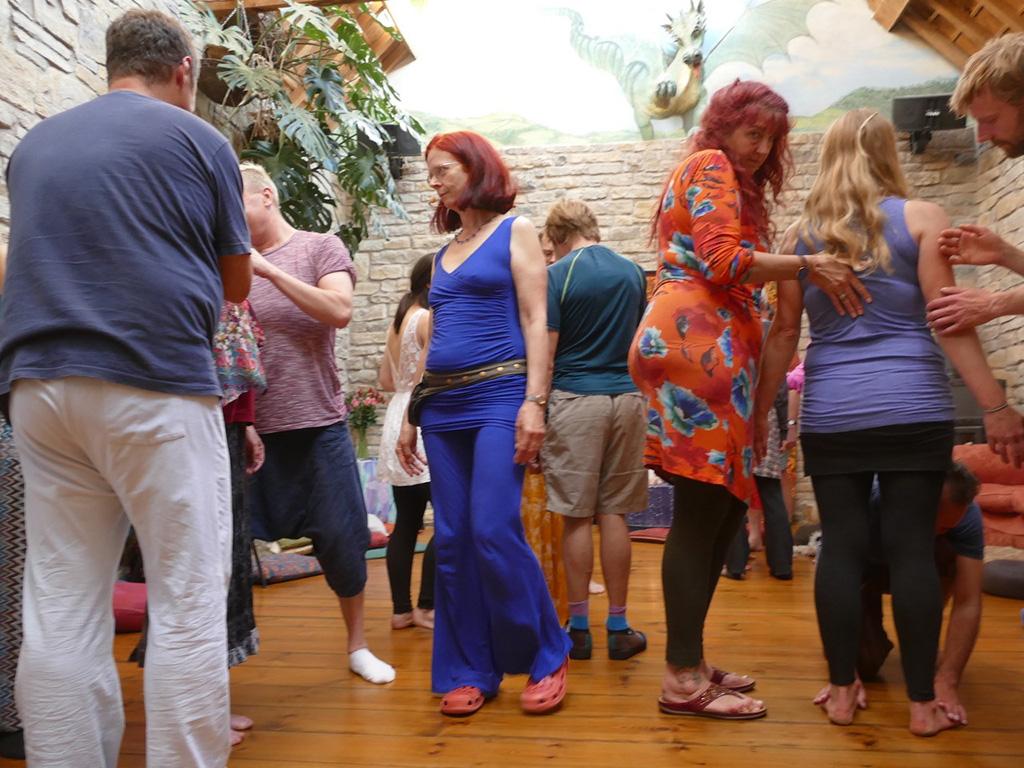The new tantra: Revolution of the soul or just sexual healing?
Oliver Bennett travels to deepest Somerset to explore the resurgence of tantra. What he finds is the ‘revolution of the soul’


It’s not every cloudy Tuesday morning that one finds oneself sitting on a cushion in a sarong, touching a stranger. Or then, getting up and dancing naked in a blindfold – and furthermore, to take that blindfold off and continue to dance naked amid 40 or 50 people. This event was Living Tantra 1 or LT1, a workshop by Jan Day in a timber hall overseen by a dragon sculpture in a sleepy Somerset village.
Willowy Day is the doyenne of tantra workshop leaders: indeed, she’s helping to popularise the spiritual practise. For tantra is going the way of yoga or mindfulness. Once a recherche taste at the further reaches of New Ageism – popularly associated with jaded rock stars and coitus non-interruptus – it’s growing, moving and populating all walks of life: from personal development; to dealing with poor body image; as an alternative to psychotherapy, even as a way to improve business practise. Day’s one-day taster workshop routinely receives 60-plus people eager to receive her message of sexuality, spirituality, love, connection and coping.

On arrival at LT1 I sat in an English country garden of glorious fecundity, and met my 50 fellow tantrikas. They really were a mixed bunch, including counsellors and massage therapists building on their core schtick, but also builders, chefs, film editors, representing all ages from 20-70 and all manner of “journeys”. Several were already Jan Day initiates, and used a particular kind of language: “I see you”; “I honour you”, “speak my truth”, “authenticity”. Some were also adept with the language of personal development and talked knowledgeably about “parts work”, “constellation work” and “shadow work”.
A disclaimer suggested that should sexual activity take place, it would be a good idea to use condoms – and later in the week there they were, like ominous petits fours on a plate in the dragon hall. Several novices baulked: surely this wasn’t going to be some kind of swingers’ bash with spiritual icing? As it turned out, no – well, not really. We danced to a soundtrack of trance music and started to shift into the LT1 zone, then broke the ice in the clothing-optional hot tub and sauna.
I awoke to a cacophony of birds at 5am. It seemed appropriate that this life-force symphony would be LT1’s wake-up call. Then, as was to happen each morning before my porridge and pumpkin seed breakfast, we went to that dragon hall to do a shaking meditation. Although redolent of raving, it barrelled down the ages. Here, in a Somerset barn, we were doing what non-conformists had done in Somerset barns four centuries ago, calling themselves “Quakers” and “Shakers”, vibrating ever-closer to the godhead.
This was the hors d’oeuvres, as it turned out. For at LT1 it is the different practices – or “structures”, as Day calls them – that are the point. They’re conducted in small groups of three or four, bringing up all kinds of “stuff”. One involved meeting fellow participants’ eyes then seeing if you could say “goodbye” to them when your attention wavered. In another, we touched participants who say “yes” if they liked it, “no” if they didn’t.
Sounds easy? Not a bit of it. In fact, LT1’s structures are a rocky ride, causing feelings of hurt, rejection and the occasional tearful exit. Just holding someone’s gaze is tough. As Day says, discomfort is to be expected. “Generally we’re used to being comfortable,” she said. “It feels safe. We tend to repeat things, because stuff outside what we’re used to feels unsafe. So we need to push the boundaries to learn. That’s why we’re here – we need to dance on the edge.”
So popular is Tantra now that people are characterising it as a movement, sometimes called “the new Tantra”. Indeed, there’s a group of that name, which holds events across Europe and the US. Known as TNT for short, its explosive workshops explore taboo and sexuality and sound thrilling or chilling, depending on your tolerance for exercises where, for example, participants role-play as parents and children then get sexually stuck in.
Then there are the OM – “orgasmic meditation” – workshops pioneered by OneTaste, a “sexuality-focused wellness education company” from the US, whose trademarked activities include stroking the yoni (Sanskrit for vagina) for many minutes and once endorsed by Gwyneth Paltrow. Both OM and TNT have suffered from negative publicity. But neither alter the fact that tantra and “intimacy coaching” have pushed the wellness envelope to new territories.

Tantra can be edgy. As Day herself says: “You don’t have to dig far in the tantra field to find group leaders having sex with participants.” She knows of organisations “doing questionable things and I’ve been horrified. It is institutionalised abuse.” The trouble is that with a charismatic leader it’s easy to be hooked in. “It’s exciting,” says Day, “and ‘exciting’ is addictive. It gets into the non-cognitive part of the brain.” And that’s where you can shelve your normal risk-adversity.
But having been there, I’m certain this is not the Day way. She has a high staff-student ratio with several assistants. “Our safety is very strong,” says Day, who has even thought about not using the ‘T’ word but kept it as it makes people “scared and interested. That said, we don’t want to blow ourselves out of the water. It provides challenges but with a container.“ As the LT1 week develops, you do make mistakes and then create boundaries, which are then taken into the world, when (in principle) you feel more able to say “yes”, “no” and indeed, “goodbye”.
At LT1 the days went by and sometimes I wanted to say goodbye to that dragon. There was, for example, a mother and father exercise with cushions representing your parents. Here, I cringed a little inside. I expected Louis Theroux to come through the door, wielding his perspicacious microphone.
But something about LT1 pushed past my scepticism barrier. Perhaps it was Day herself. Sometimes stern and brisk, sometimes maternal, she spoke about how LT1 would make you “juicy”, and how “delicious” outcomes would ensue, provided we remained within our boundaries – and that included herself and partner Frieder, who wade through transference. “Lots of people project Mummy and Daddy on us. We have to be super-careful and not bask in the projection or climb on a pedestal.”
So, what motivates people to do tantric workshops like LT1? Some came with issues such as bodily shame and past trauma. Shanti Penelope Lawrence, once a translator and now training to be a massage therapist, had got to the point where she’d been passing out with anxiety and agrophobia.
“Trauma is held in tissues, cells and muscles from abuse and neglect,” she said, but in LT1 she felt “witnessed” and a sense of renewal. Sue Allsworth had experienced abuse with a trusted adult, and as a result, ended up “not liking my body. I took to sex addiction, drug abuse, booze: I was like something on The Jerry Springer Show.”
People think it’s about sex. But it’s actually about intimacy
She thought that LT1 was good for “anyone who wants to reconnect with their physical body – and to learn to say ‘yes’ or ‘no’. It’s like a reprogramming.” Others had experienced depression and self-harm – then again, plenty hadn’t as far as I could ascertain. Sobbing, anger, proclamations of love: all were to be found at LT1 but not catharsis for its own sake, as one might find in ‘primal scream’ therapy. “That has been discredited,” said Day. “If you practice anger, you just become more angry. It’s not just about being wounded – a lot of people come because they want to grow more and have more aliveness.”
As for tantra – yes, it includes sex, but in a wider sense. “In the context of our culture where we’ve made sex disgusting, we connect sex and heart,” said Day. “But at LT1, while people get steamy and it looks like sex but rarely is.” Those condoms were an insurance policy – but also spoke about the need for honesty. Day is big on truth. Why deny sexuality? “When I was young, my sexual journey was completely messed up by what an adult said,” she says. “I became terrified of sex. I was married for three years and left the marriage a virgin.”

A chemist doing a D-Phil at Oxford University, Day became a high-functioning professional. But her unsatisfactory personal life led her to the late Osho: once best known as the Bhagwan Shree Rajneesh. Although reputationally shelled by Netflix’s film Wild Wild Country, Osho has been a guiding influence on the new tantra. “He was a tantric master who wanted to bust the idea that you can either have sex or spirituality but you can’t have both,” says Day. “And you can’t get in touch with your sexuality without getting in touch with your sexuality. Sexuality is always screwed up by religion. Tantra brings it back to sweetness, sacredness and delight.” As Sue Allsworth said, “People think it’s about sex. But it’s actually about intimacy.” And vulnerability, and shame. Inspirational speakers like Ted talker Brene Brown are big among many new tantrikas.
OK. Might predatory men come to LT1 to get their spiritual rocks off? “I don’t weed out anyone on that basis,” says Day. “I don’t mind why people come. Those people need it most.” One male participant, she says, got a lot of feedback about not being trusted. “It shook him. It was difficult medicine but it changed his relationship with women and himself – like a reset button.” For reasons like this, in LT1, it’s important to work with people that you might not always choose. They can be the most revealing.
The sources of LT1 are various. Day cites the Art of Being – an Erich Fromm phrase that became taken up by Alan Lowen – and other personal development leaders such as Jack Kornfield, David Deida, Ron Kurtz, Genpo Roshi and Anne Geraghty. There are aspects of the movements for “radical honesty” and “radical self-reliance” – the ethos of Burning Man’s “burners” – and just occasionally, tantra returns to ancient scripture. But Day doesn’t “want to do something made rigid centuries ago”. This is a contemporary adaptation.
As the end of LT1 approached, the various structures coalesced into a sensuous “initiation” in which each participant was in turn showered in feathery touches and taken through an experience of two hours of deep breathing and haptic heaven. It’s a great feeling and an almighty dopamine hit, with an inevitable comedown when LT1 ends.
Some fall in love or give up their jobs. But Day tells everyone to “land softly. Give yourselves two weeks before you even start looking at big decisions, and go slowly. You need to come down to the ground before giving up your job or divorcing.” Generally, she says, people in relationships take their LT1 tools back to their quotidian lives – partners, homes and jobs – feeling more vividly, gaining deeper empathy, even resolving conflicts more easily. And it leaves an impulse to keep growing. “If you keep growing you won’t be dissatisfied,” says Day.
The wider therapeutic world seems to be opening up to work like Day’s. A psychotherapist who attended LT1 observed that the “neurology was catching up”, particularly in regard to emotions and trauma being embodied or ‘somatised’, and necessitating physical work to liberate those feelings. Day has started a research project with Sheffield Hallam University to examine her results, and an LT1 participant, Martin Hartman, who’d been in business management in Austria, has set up a tantra-influenced coaching company called Ecstatic Business.
With eye contact, honesty, trust and meditation, he claims a company’s bottom line could be improved. “It has already worked,” he said, “although of course touching is less acceptable than ever.” Day knows of a Belgian supermarket that sent its workers to tantric workshops. “It’s a revolution of the soul,” she says – and post-LT1, I’d agree that we do sometimes need to “dance on the edge”.
For more information please visit https://www.janday.com/
Join our commenting forum
Join thought-provoking conversations, follow other Independent readers and see their replies
Comments